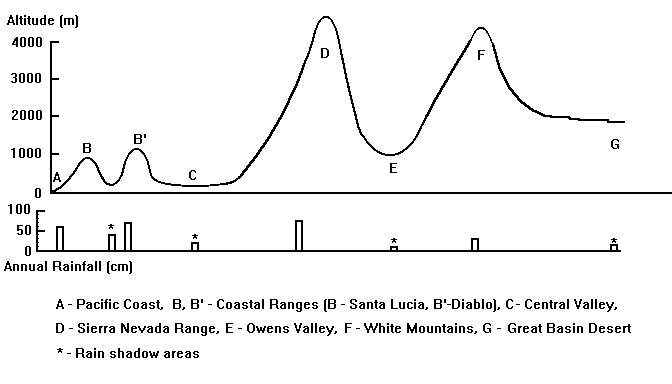
How to use these slides in teaching
Three remarkable trees live on a small part of our planet, in western United States and mainly in the state of California. They live in environments very distinct from each other, and studying these plants gives us an opportunity to discuss how climate is affected by mountians, hand how each particualr tree is adapted to its special enviroment. In addition to the general story followed by the script, the slides can also be used separately in teaching the following different concepts: How land features affect climate, Rarity and extinction in plants, Differences between gymnosperms and angiosperms, and An introduction to the Metric sytem.
How land features affect climate
The moist prevailing winds from the Pacific ocean blow inland from the northwest coast, especially during cooler months. When the sind is diverted by mountains it loses some of its moisture, because the air mass is lifted, the air cools, and moisture condenses. When it drops down on the leeward side of the mountains it is much drier than before. If we make a transect from the California coast we see that the wind passes over four such parallel ranges. Each of these extracts moisture so that the air mass reaching the Nevada desert is extremely dry. This, of course, is the well-known rain-shadow effect, and the slides give an excellant example of the phenomenon.

Rarity and Extinction in Plants
The appearance and disapperance of organisms appears to be fundamental to the enloution of life. The question, when we see ana nimal or plant that is extremely rare, is whether this scarcity is evidence for the newness or age of a particular species. In this presentation we give several expamples of rareness int eh districbutions of plants: the cobra lily, coast redwood, bristlecone pine, tan oak, and the big tree. The age of the species can be deduced from varius factors. For the redwoods, fossil evidence exests from which we conculde that the trees have been in existence for a long time and ovnce had much wider distributions. The bristlecone pine grows on geologiclally youthful mountains in southeastern U.S., and within this range it is variable in appearance. From this we can reasonably conculde that it is a relatively young species, for a conufer. The cobra lily is quite distinct from other liviing plants and has an extremely limited distruibution--probably a fairly old species for a flowering plant. The tan oak is closely related to other species of a genus of mainly trpoical montane forests of Southeast Asia. It is most likely that the species dates back to the time when a more mild global climate permitted its migration from its center of distribution in Southeast Asia--a fairly old species.
Differences between gynmosperms and angiosperms
In this presentation there are ample illustrations to show basic differences between them, sice the reproductive features are shown. The most dignificat difference is that in a flowering plant (angiosperm) the seed is protected by the ovary and matures inside of a fruit. A conifer (among other gymnosperms) producses seeds on the bracts of the cone. At maturity the seeds are not protected by any structure and are "naked". A clear contrast can be made with the fruits of the tan oak.
An Introduction to the Metric System
This topic provides an opportunity to five concrete examples for comparing certain metric and English measurements: centimeters versus inches, meters versus feet, and metric tons versus English tons. I have tried to interweave all of these thems in the script that follows in the slide show.
Back to the main page